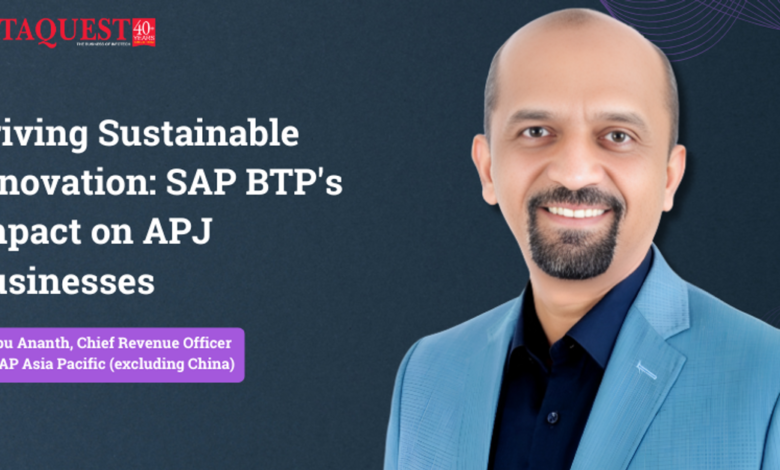SAP BTP’s Impact on APJ Businesses

In an exclusive conversation with Subbu Ananth, Chief Revenue Officer, APJ, SAP BTP, we delve into SAP’s recent initiatives, focusing on the Business Technology Platform (BTP) and core modernization strategies. Ananth shares comprehensive insights into SAP’s approach tailored for emerging markets like India, highlighting the platform’s significance in driving sustainable growth and innovation.
Can you elaborate on SAP’s emphasis on the adoption of SAP Business Technology Platform (BTP) and its significance for businesses in the APJ region?
SAP is strategically pushing for BTP adoption across the APJ region, recognizing it as a pivotal driver of digital transformation. BTP represents a paradigm shift in how businesses approach software development and customization. Traditionally, organizations heavily relied on on-premise customizations using ABAP, leading to complex architectures and lengthy development cycles. However, BTP offers a fresh perspective by promoting a clean core architecture. This approach enables businesses to build extensions and customizations on a separate platform, ensuring agility, scalability, and easier maintenance. The significance of BTP for businesses in APJ cannot be overstated. In a rapidly evolving market landscape, where agility and innovation are paramount, BTP serves as a catalyst for driving growth and competitiveness.
How does SAP tailor its strategies for developed versus emerging markets in the APJ region, particularly in terms of technology adoption and growth initiatives?
SAP’s approach to developed and emerging markets in the APJ region is nuanced and adaptable, reflecting the diverse needs and maturity levels of these markets. In developed markets like ANZ and Japan, where technology adoption rates are relatively high, SAP focuses on innovation and advanced solutions tailored to the specific challenges faced by businesses. These markets serve as incubators for cutting-edge technologies, driving SAP’s agenda for continuous innovation. On the other hand, in emerging markets like India and Southeast Asia, SAP adopts a more holistic approach, recognizing the need to support businesses in their digital transformation journey from legacy systems to modern, cloud-based solutions. This involves not only providing innovative technologies like BTP but also nurturing the ecosystem through partnerships and capacity-building initiatives. By tailoring its strategies to the unique characteristics of each market, SAP aims to accelerate digital adoption and drive sustainable growth across the APJ region.
Absolutely. The impact of SAP BTP on businesses in India is profound and far-reaching, with numerous success stories across various sectors. Take Air India, for instance. By leveraging SAP BTP, Air India successfully integrated over 100 applications, ranging from passenger management to flight operations, resulting in significant operational efficiencies and improved customer experiences. Similarly, Mahindra & Mahindra, a leading automotive manufacturer, has revolutionized its core business processes through BTP. By implementing Intelligent Robotic Process Automation (IRPA) capabilities offered by BTP, Mahindra & Mahindra has automated over 250 processes across its value chain, reducing manual efforts and enhancing productivity. These examples underscore the transformative potential of SAP BTP in driving innovation, operational excellence, and business agility in the Indian market.
Ensuring responsible AI development within its Business Technology Platform (BTP), what measures does SAP employ, and what key considerations are essential in this endeavor?
Responsible AI development is a cornerstone of SAP’s approach to innovation, particularly within its Business Technology Platform (BTP). SAP recognizes the ethical implications of AI and is committed to ensuring that AI technologies developed and deployed through BTP adhere to the highest standards of ethics and accountability. One key consideration in this regard is grounding AI models in real-world business scenarios. By anchoring AI development in the context of business processes and objectives, SAP ensures that AI solutions deliver actionable insights that drive tangible business value. Additionally, SAP prioritizes transparency and explainability in AI systems, enabling users to understand the rationale behind AI-driven recommendations and decisions. Moreover, SAP places a strong emphasis on fairness and equity, actively addressing biases and ensuring that AI solutions do not perpetuate or exacerbate existing inequalities. By embedding these principles into the fabric of BTP, SAP aims to empower businesses to harness the transformative power of AI responsibly and ethically, driving sustainable growth and societal impact.
How does SAP BTP empower businesses in APJ to attain their sustainability objectives?
Sustainability is increasingly becoming a priority for businesses in the APJ region, and SAP Business Technology Platform (BTP) offers tailored solutions to tackle this challenge head-on. For Indian businesses particularly, the Green Ledger application helps streamline compliance with regulatory sustainability reporting requirements, a crucial aspect given the region’s focus on sustainability.
However, the true strength of SAP BTP lies in its versatility. Businesses can harness the platform’s development capabilities to craft custom sustainability solutions that cater specifically to their unique needs and objectives. This adaptability ensures that organizations can address specific reporting mandates and environmental initiatives effectively.
Moreover, the BTP Enterprise Agreement (EF) presents a cost-effective approach, allowing businesses to pay only for the services they utilize. This flexibility enables the activation of features like AI integration, empowering organizations to enhance their sustainability efforts while optimizing resource allocation.
SAP fosters a culture of co-innovation through collaborative initiatives in its labs, partnering with key customers to develop innovative use cases. This collaborative spirit is exemplified in the recent launch of a sustainability reporting solution, underscoring SAP’s commitment to driving sustainable practices through technology.
Conclusion:
SAP’s strategic vision for the APJ region revolves around driving innovation, fostering digital transformation, and empowering businesses to thrive in a rapidly evolving market landscape. Through initiatives like the adoption of SAP BTP and core modernization strategies, SAP is poised to accelerate the pace of digital adoption and drive sustainable growth across developed and emerging markets alike. By tailoring its approach to the unique needs of each market and prioritizing responsible innovation, SAP aims to position itself as a trusted partner in the digital journey of businesses across the APJ region.
As businesses embark on their digital transformation journey, SAP offers a compelling suite of solutions and services, anchored by SAP BTP, to drive innovation, agility, and competitiveness. Organizations in the APJ region are encouraged to explore the transformative potential of SAP’s offerings and leverage them to unlock new opportunities for growth and success. By partnering with SAP and embracing a culture of innovation and responsible AI development, businesses can chart a path towards a more sustainable and prosperous future in the digital age.



